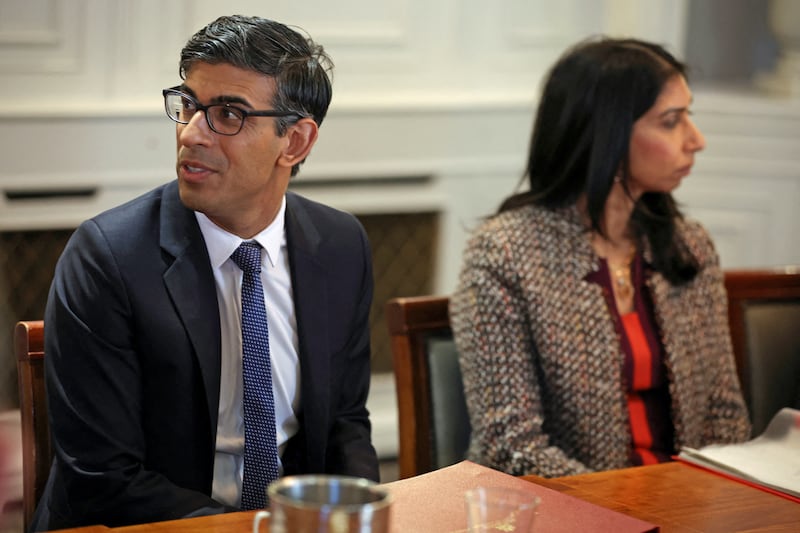There was an undeniable giddiness about Westminster on Monday in the hours after David Cameron’s sensational return to government as foreign secretary was announced. Dad’s back. Does this mean everybody has to do their homework now?
It would be difficult to overestimate the sense of shock at his return. The moment is best captured in a now viral Sky News clip of Cameron’s big reveal, when he stepped out of a black Range Rover on Downing Street just before 9am and strode into Number 10.
Presenter Kay Burley and deputy political editor, Sam Coates, both gasped when he appeared, before shouting his name in unison. “Whaaaat?!” said Burley. “I was not expecting that!” Nobody was. The sense of triumph at having delivered an unexpected plot twist radiated like sunshine all day from Downing Street officials.
At 11am, after his Downing Street meetings with reshuffle candidates such as Cameron and Therese Coffey, who was allowed quit as environment secretary, Sunak was driven in a convoy the half mile to parliament, where he sacked a few more junior ministers in his office behind the House of Commons.
READ MORE
He left again about 45 minutes later. His convoy could be seen exiting through one of the arches into New Palace Yard, the secure garden in front of the colonnade that runs from the tunnel underneath Bridge Street to the House of Commons. Sunak’s driver then sped back to Downing Street in a flash of blue light.
Upstairs in the bustling lobby of Portcullis House, the modern office building and political workplace that is attached to parliament via the tunnel, most people seemed to be taking an early lunch. It was probably more out of a desire for gossip than food – Cameron in and Suella Braverman, the outspoken home secretary, out. A new cabinet veneer in one fell swoop.

The Cameron move caused most excitement, but Braverman’s inevitable sacking also caused a stir. There was little love lost between her and Liz Truss, the former Tory leader who was the first prime minister to sack Braverman as home secretary last year for using her personal email to leak sensitive immigration papers to a backbench ally. Braverman then accused Truss of not doing “serious politics”, which damaged the then-PM as she was already teetering on the brink.
A few hours after Braverman’s second coming was ended by Sunak, Truss could be seen strutting through the Portcullis House Lobby followed by her adviser, who was wearing his trademark white jacket. Truss, meanwhile, was wearing a broad, white smile. The implication was obvious: she didn’t seem at all unhappy at how the day’s events had played out.
Later in the afternoon, the Westminster media lobby pack traipsed up to Number 9 Downing Street for a briefing on the farrago from Sunak’s officials. As darkness descended, the media “pen” outside Number 10 was bulging with broadcast journalists and camera crews wondering if Sunak had another reshuffle surprise planned.
Inside Number 9, two of Sunak’s closest advisers faced a packed briefing room. The wood-panelled chamber was built by Boris Johnson when he was prime minister for what was planned as daily White House-style briefings by his team. The pandemic intervened, scuppering the gatherings. Then the broadcaster that Johnson hired to conduct the briefings was forced out after she was caught in leaked footage from the room laughing about Christmas parties during lockdown. The Number 9 media room has rarely been used since, and it certainly hasn’t seen many days as dramatic as Monday.
Sunak’s advisers insisted the idea to bring back Cameron was the prime minister’s, despite rumours that former foreign secretary William Hague brokered the deal. It was later briefed by officials that Sunak offered Cameron the job last Tuesday night in a private meeting in the flat above 11 Downing Street. That was a full 24 hours before Braverman wrote a controversial opinion article in the Times about protests and policing, which had been seen as a contributor to her sacking.
Sunak’s advisers waved away questions about whether the move to revive the career of Cameron, who left government seven years ago, was proof the Tory party had run out of fresh talent. Cameron has been brought back for his foreign policy experience, they said. What landmark foreign policy achievements does he have? Sunak’s adviser hesitated for a moment, before alighting on Operation orbital, the UK effort to train Ukrainian troops after its 2014 invasion by Russia.
They didn’t mention the UK’s disastrous bombing of Libya in 2011, which was heavily criticised afterwards in a parliamentary investigation. Or Cameron’s feting of China, which Sunak later described as naive.
Cameron was the prime minister who called the Brexit referendum and then, as the chief campaigner for Remain, lost it. Sunak was an arch Brexiteer. Does the new foreign secretary believe in Brexit? “Yes, of course,” came the reply from one of Sunak’s officials.
For all its foibles and inconsistencies, the centre ground appears to be coming back into fashion in British politics.















